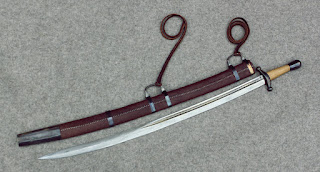Szabla Awarska – tak umownie nazwałem ten model, choć właściwie broń tego typu była używana przez wiele ludów koczowniczych z grubsza na terenach od dzisiejszej Ukrainy na wschodzie po Słowację i Węgry na Zachodzie. Czasem bywa nazywana wczesną szablą węgierską. Ciekawym przykładem tego typu szabli jest bogato zdobiona szabla Karola Wielkiego (choć bardziej prawdopodobne jest, że powstała w czasach o ok. 100 lat późniejszych niż koronacja Karola na cesarza rzymskiego w 800r n.e., czyli ok. roku 900 n.e.). Sam Karol Wielki toczył wojny z Awarami (wcześniej Awarowie toczyli wojny przeciwko Frankom, więc jakaś „tradycja” już była), a ich Kaganat upadł w zasadzie w kilka lat po jego śmierci. Jedna z hipotez głosi, że szabla ta była łupem wojennym, który cesarz zdobył w walkach z Awarami. W miejsce pokonanych Awarów osiedlili się inni koczownicy - Madziarzy, czyli Węgrzy.
Do czasów obecnych na wspomnianych wcześniej terenach sporo znaleziono tego typu szabel, różniących się oczywiście od siebie różnymi szczegółami, ale w pewien sposób do siebie podobnych. Znaleziska archeologiczne mają tę wadę, że trudno jednoznacznie stwierdzić, jacy ludzie danych przedmiotów używali, jakim językiem mówili, jaki etnos reprezentowali. Na dodatek przedmioty materialne czasem zmieniały właścicieli czy to w drodze handlu, czy zdobyczy wojennej (jak np. teraz czołgi na Ukrainie). Dlatego umownie nazwałem tę szablę szablą awarską. Egzemplarz, który wykonałem nie jest kopią konkretnego znaleziska, ale reprezentuje styl. Poszczególne elementy wzorowane są na różnych znaleziskach. Głownia jest z innego, jelec z innego, głowica z innego, pochwa z innego. Pomimo to całość wygląda dość spójnie.
Właściciel, miłośnik broni białej dawnych kultur, nadał jej imię Zofia, co znaczy mądrość. Szabla jak na szablę ludów wędrownych przystało, też przebyła dość długą drogę, bo za ocean. Obecnie zdobi kolekcję swego właściciela w Tennessee.
Pochwę wykonał Piotr Hoffer (elementy drewniane, klejenie klejem kostnym, obszycie skórą jelenia).
Kilka jego prac można zobaczyć tutaj:
https://www.deviantart.com/f161?fbclid=IwAR0j3aDbPnocPHit7j3mVY95EkhShZpMiokAowEZ1aR3bKeS86I91hu-5Do
Kaganat Awarów:
https://pl.wikipedia.org/wiki/Kaganat_Awar%C3%B3w
Szabla Karola Wielkiego:
http://myarmoury.com/review_casi_charlemagne.html
Avar saber
Avar saber - that's what I called this model of sword, although in fact this type of weapon was used by many nomadic peoples roughly in the areas of what is modern Ukraine in the east to Slovakia and Hungary in the west. It is sometimes called an early Hungarian saber. An interesting example of this type of saber is the richly decorated saber of Charlemagne – Charles the Great (although it is more likely that it was created about 100 years later than the coronation of Charles as Roman emperor in 800 AD, i.e. around 900 AD). Charlemagne himself fought wars with the Avars (before that, the Avars fought wars against the Franks, so there was already some "history" between the two), and their Khaganate fell basically a few years after his death. One hypothesis is that the saber was a spoil from the war that the emperor won in the battles with the Avars. Other nomads known as Magyars - Hungarians - settled in place of the defeated Avars.
Until now, in the aforementioned areas, many such sabers have been found, differing of course in various details, but similar to each other overall. Archaeological finds have the disadvantage of being difficult to associate to a specific group: which people used the objects, what language they spoke, what ethnos they represented. In addition, tangible items sometimes changed hands, either through trade or through war gains (like the tanks currently being captured in Ukraine). Therefore, I conventionally called this saber the Avar saber. The copy I have made is not a copy of a specific find, but it does represent the style. Individual elements are modeled on various finds. The blade is from one example, the cross from another, the pommel from another, and the scabbard from another. Despite this, the whole thing looks quite consistent overall in form.
The owner, a lover of blade weapons of ancient cultures, gave it the name Zofia, which means wisdom. The saber, as befits a sword of nomadic peoples, also traveled quite a long way, even crossing over the ocean. It now adorns its owner's sword wall in Tennessee, a prized piece of his collection.
The scabbard was made by Piotr Hoffer (wooden elements, gluing with bone glue, deer leather sewing). Here you can see some of his works:
https://www.deviantart.com/f161?fbclid=IwAR0j3aDbPnocPHit7j3mVY95EkhShZpMiokAowEZ1aR3bKeS86I91hu-5Do




























Brak komentarzy:
Prześlij komentarz